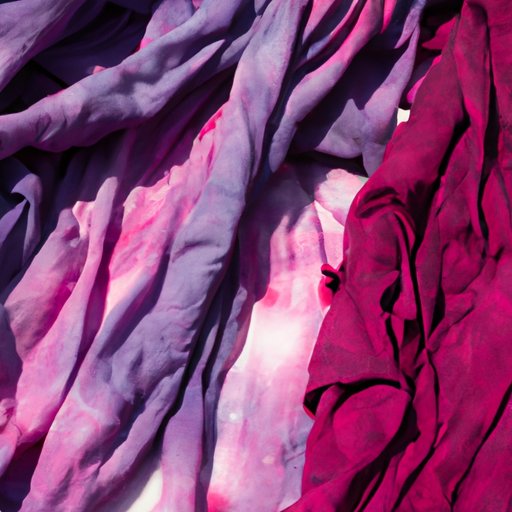
Introduction
Are you tired of your plain clothing and want to give them a new life? Look no further than Rit dye, a versatile and easy-to-use fabric dye that can help you achieve vibrant colors on a variety of materials. Whether you’re new to dyeing or an experienced crafter, this article will guide you through using Rit dye to its fullest potential.
Step-by-step guide on using Rit dye
Dyeing clothes with Rit dye is a simple process that requires just a few steps. To get started, gather your materials, including Rit dye, fabric, salt (if dyeing cotton, rayon, or linen), and hot water. Next, follow these steps:
- Wet fabric in hot water and wring out excess water.
- Mix dye with hot water and salt (if necessary) in a container, following the ratio on the package.
- Add the wet fabric to the dye bath and stir for the recommended time (usually 10-30 minutes).
- Rinse fabric in cold water until water runs clear.
- Wash fabric in warm water with a mild detergent and dry it.
To achieve the best colors, it’s important to follow the instructions on the package and consider a few tips. First, be sure to wear gloves to avoid staining your hands. Use hot water for cotton, rayon, and linen fabrics and warm water for synthetic fabrics. Keep the dye bath moving to prevent uneven color and add more dye for deeper shades. Finally, wash the dyed fabric separately from other clothes to prevent bleeding.
Tie-dye techniques using Rit dye
Tie-dye is a fun and creative way to use Rit dye, and there are many techniques to choose from. Here are a few traditional patterns to try:
- Spiral: Pinch the center of the fabric and twirl it into a spiral shape. Use rubber bands to hold it in place and dye each section a different color.
- Stripes: Fold the fabric in accordion-style and tie rubber bands around it at intervals. Dip each section in a different dye color.
For more unique and beautiful tie-dye designs, consider trying ice dyeing or shibori. In ice dyeing, sprinkle ice on top of the fabric and apply dye on top. Wait for the ice to melt and rinse the fabric. In shibori, use folding or binding techniques to create patterns before dyeing the fabric.
Benefits of using Rit dye
Compared to other dyes on the market, Rit dye offers several advantages. One major benefit is affordability, as Rit dye is relatively cheap and can be found in most craft stores. Another advantage is versatility, as Rit dye can be used on a variety of materials beyond clothing, such as curtains, tablecloths, or even doormats. Additionally, Rit dye offers eco-friendliness options.
Unconventional uses for Rit dye
Although Rit dye is primarily used for clothing, it’s also a great way to add color to non-clothing items. Try using Rit dye to dye mason jars, pillowcases, or home decor fabrics. For example, tie-dye a table runner for a party or dye a curtain to match your decor. The possibilities are endless!
Best fabrics and materials for using Rit dye
While Rit dye can be used on most natural and synthetic fabrics, certain materials work better than others. Cotton, rayon, and linen fabrics absorb dye best, while polyester and silk fabrics require special attention. Prepping the fabric for dyeing is also an important step in achieving the best results. For example, washing the fabric beforehand can help remove any dirt or debris and improve dye absorption.
Dyeing fabric in large quantities
Dyeing larger items like bed sheets or curtains might seem daunting, but it’s possible with Rit dye. Simply double or triple the amount of dye and follow the same steps, making sure to evenly distribute the dye and monitor the color to avoid over-dyeing or uneven color.
Frequently asked questions about Rit dye
Here are some answers to common questions about Rit dye:
- How long should I leave fabric in the dye bath? This depends on the fabric and color but typically between 10-30 minutes.
- What water temperature should I use? Use hot water for cotton, rayon, or linen fabrics, warm water for synthetic fabrics, and cold water for rinsing.
- What should I do if the color is too light? Try dyeing the fabric again with a longer time in the bath or more dye.
For more information on troubleshooting issues with Rit dye and other tips, visit the Rit Studio website.
Conclusion
Overall, Rit dye is an accessible and creative way to add color to your life. Whether you’re dyeing clothes, tie-dyeing, or exploring unconventional uses, Rit dye offers versatility, vibrant color, and eco-friendliness options. Don’t be afraid to unleash your creativity and try dyeing with Rit dye.




